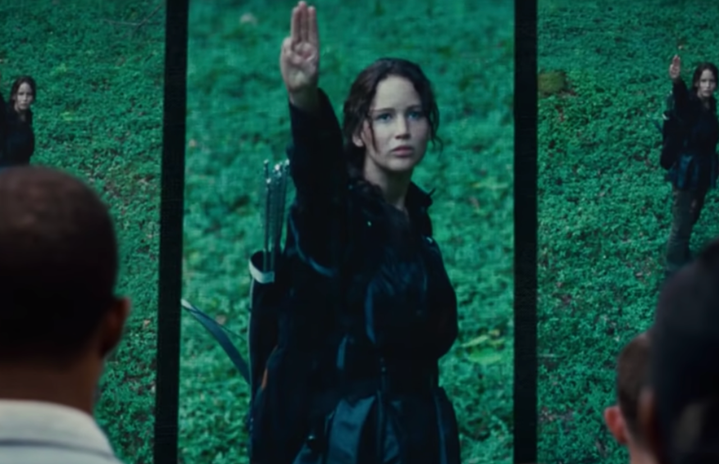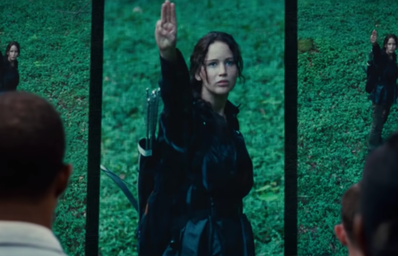Disclaimer: this article contains spoilers for The Hunger Games.
There has been a recent resurgence of The Hunger Games-themed media, namely on the ever-popular TikTok app. Personally, I began reading the series when I was an 8-year-old (which may be entirely too young), so reentering the fictional world Suzanne Collins has expertly built has been like exploring a childhood home.
For those who don’t know, The Hunger Games is set in a post-civil war America, Panem, in which children ages 12-18 are forced to compete to the death in a sensationalized reality show as penance for the uprising. The country is composed of 12 districts, each of which supply the utopian Capitol of Panem with different resources to afford them their luxurious lives. The books follow Katniss Everdeen, a teenage girl who volunteers in her sister’s place in the games and starts a revolution in her quest to survive.
The only things that are nearly as good as the The Hunger Games books are the movies. Since Suzanne Collins herself was heavily involved in the movie adaptations of her novels (even serving as a screenwriter for The Hunger Games and The Hunger Games: Mockingjay – Part 1), it’s only natural that fans were satisfied on the whole with the movies. Putting concrete imagery to books is not always as fulfilling as reading words on the page, but one of the factors that makes these movies incredible is the wardrobe. Many colors are used to portray different things throughout the films, but the ones I’d like to focus on are black, white, and gray. Each color also means a different thing for every character—one character being dressed in white does not necessarily correlate to another in the same color.
First, we must start with the most obvious: Katniss and President Snow. Throughout the movies, Katniss is consistently dressed in black to contrast Snow’s white outfits. President Snow is the face of the classic dystopian oppressive regime. He is the primary antagonist of the entire series, as he represents and is at the helm of a corrupt government. While Katniss is not at the head of Panem’s rebellion, she is the face of it. These two are opposed throughout the entire series.
While white is normally associated with purity, it takes on a new meaning on President Snow’s body. Since he promises safety and order but truly has ulterior motives, the color is all the more unsettling on him. Katniss, on the other hand, often wears black, especially towards the end of the series. Katniss is in direct opposition to Snow, so it only makes sense that she would don black outfits.
This isn’t the only meaning, though. Even after the Hunger Games end, President Snow and Katniss are constantly playing a complex game to try and overtake the other. They’re not just dressed in black and white because they’re opposites—the colors represent a game of chess.
Katniss and Snow definitely have eye-catching ensembles, but we can’t forget about our fan-favorite Peeta Mellark. Peeta goes through a lot in The Hunger Games: Mockingjay – Part 1, the third film in the series. He’s kidnapped by the Capitol at the end of the second film and forced into televised interviews to get back at Katniss for leading a rebellion. His outfits reflect his inner turmoil as he is changed by the Capitol.
When we first see Peeta post-Capitol capture, he’s donning an entirely white outfit. As he stares into the camera and calls for a cease-fire, he is at his full mental capacity. He hasn’t had his memories manipulated by the Capitol yet, meaning that he has a clear head (or as clear as it can be after you survive two battles to the death). However, the next time we see Peeta on-screen, he’s a little more out of it. His eyes are sunken in, he looks thinner, and he has a harder time speaking. And what is he wearing? A black suit with a light and wispy white pattern on it. This coloring of his suit represents his descent into madness—while there is still a part of his pure self within him, he is being clouded by the Capitol’s manipulation.
While we’ve covered black and white, there is also another color used deliberately in The Hunger Games: gray. President Alma Coin of District 13’s arrival comes as a surprise in the third book and movie. As she steps in to lead the rebellion, it becomes increasingly clear that her actions are motivated by self-interest and not liberation. To represent her gray morality, she is usually depicted in gray clothing, most notably during the public execution of Snow. That’s not all: Coin also has a stripe of white hair before her gray hair. This may be indicative of how she promises integrity (much like Snow), but is actually a morally gray character.
Peeta is also dressed in a gray suit during his last Capitol broadcast before being rescued. In this scene, he is his most beaten down and broken. The Capitol has left him without a family and without any sense of which memories of his are real. In this scene, Peeta being dressed in gray represents how muddled his mind is. Since the Capitol implanted false memories into his mind to turn him into a weapon against the rebellion (and namely Katniss), he is constantly trying to differentiate real from fake.
While only a couple of these theories have been confirmed, I have a hard time believing that clothing in these movies is anything but intentional. For those who haven’t watched or read any of the The Hunger Games movies or books, I urge you to devour them—and may the odds be ever in your favor.




